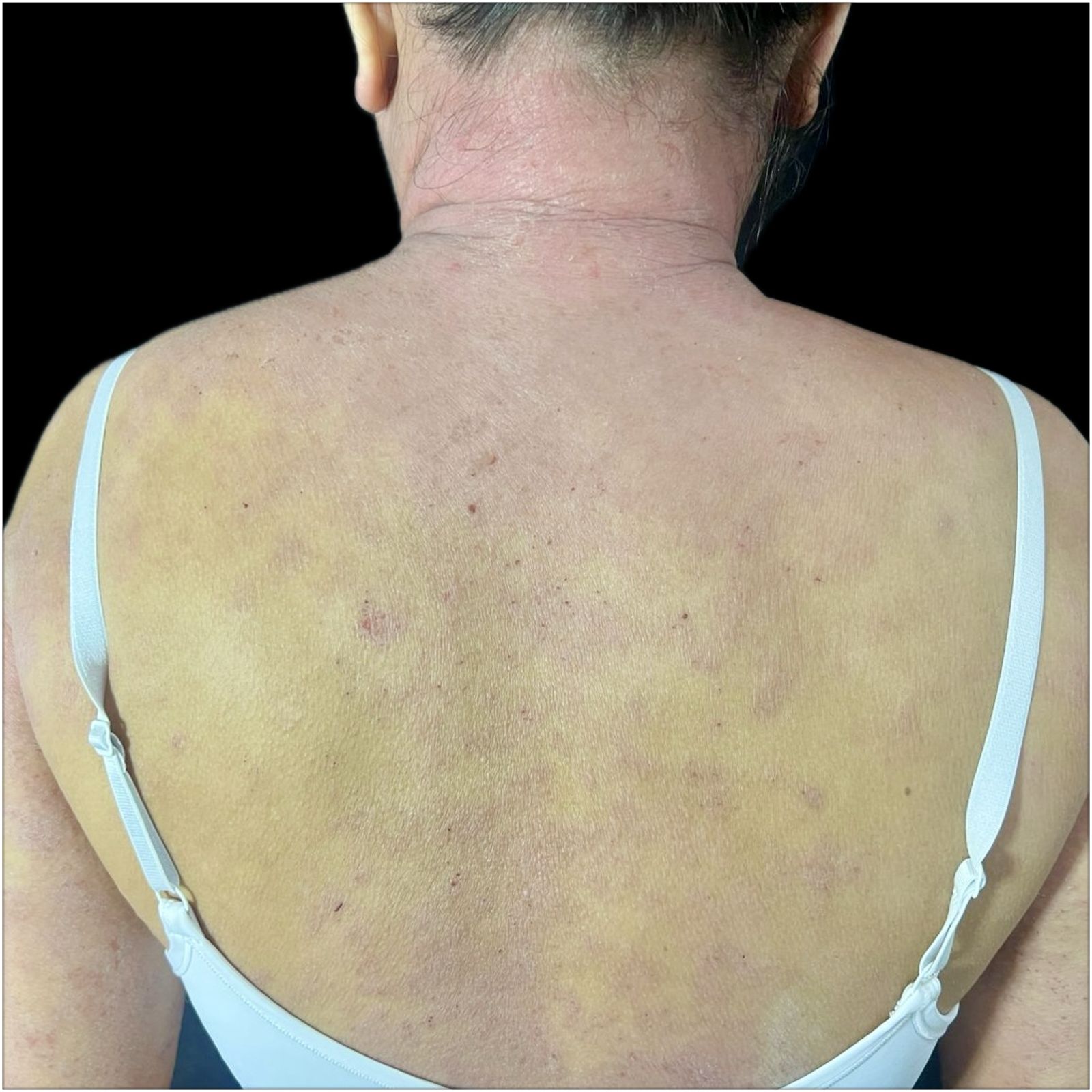Allergen
Golf
It’s certainly got its fans but make no mistake, golfing has many, many top contact allergens and other things that can cause skin problems. This isn’t to say that you shouldn’t play it — just make sure to be guided by your patch test (and follow other best practices; see below).
Some of the common contact allergens you might be exposed to while golfing include:
- Grass and the pesticides and thiuram used to maintain it.
- Fruit trees, plants, and flowers, which can also cause airborne contact dermatitis — a lot of them are also photo-allergens, which react with light to cause hyperpigmentations.
- Rubber (plus carba mix and other related materials in rubber), leather, glues in gloves, shoes, club handles, and other accessories.
- Acetophenone azine (found in some shoe soles) and other foamy, cushioned equipment and accessories.
- Lots of sporting apparel is black or dark blue, which may have PPD and disperse blue. Brightly-colored clothes would tend to have dyes. Socks and stretchy apparel usually have elastics.
- Formaldehyde-releasing and other preservatives used in clothing, shoes, and some other gear.
- Nickel in metal clubs, tees, divot tools, and other accessories.
Playing golf also means hours under the sun. In addition to the photo-aging and risk of skin cancer, many allergens are also photo-allergens, which react with light to cause skin darkening. Wear a very good, hypoallergenic (to avoid more allergens and photo-allergens) sun and light screen like Armada Sport 70 or Stay-On-Point!
The rest of your skin that is covered by clothing, hats, and shoes is in an enclosed, hot, humid environment for hours. This can increase the likelihood of contact allergies or worsen existing ones. It can also be an ideal environment for microbes to flourish, leading to acne, sweat “acne,” other fungal or bacterial infections, warts (viral), irritant contact dermatitis due to friction and exposure to sweat, contact dermatitis to soaps or lotions that you use on your body or detergents you use to wash your clothes, etc.
What can help?
- Get a patch test so you’re not guessing — golf gear can be costly so you want to be clear about what materials you can use (for example, you might be fine with vegetable-tanned leather).
- Use clothing and socks without your allergens. There are some latex, elastic-free, dye-free options with organic cotton (check out Cottonique.com).
- If you have patch tested positive to rubber, nickel, and related substances, try using an organic, untreated, uncolored cloth barrier (like a towel, gloves, or cloth) between you and the equipment or surface. Just remember to check with a qualified instructor to ensure your safety, especially when lifting heavy things.
- A purely mineral, non-comedogenic barrier-protective product like Stay-On-Point! or Armada Baby or Post-Procedure on exposed skin is a great barrier against airborne contact and direct contact allergens. Applied on skin under gloves/other barriers may also help to minimize contact between skin and allergens.
- Bathe with allergen-free body wash or soap. Importantly, most VMV Hypoallergenics products also contain coconut-derived monolaurin, a non-allergenic, microbiota-friendly broad-spectrum antimicrobial to help with the wide range of possible infections.
- Before putting on your socks, shoes, or other gear under which you expect to get really sweaty, try this great technique for sweat and microbial control: spray the areas with Essence Skin-Saving Antiperspirant or Essence Stay Fresh-ener (in the USA) then massage Id Monolaurin Gel or Kid Gloves all over the areas. Both can be reapplied as needed.
- For barrier repair of irritated skin and microbiome balance, massage Know-It-Oil or Oil’s Well liberally all over before bed.
- Don’t store your shoes and gear in enclosed containers. Air them out frequently and keep them stored in open shelves(they tend to get better air circulation than in a closet).
- Bring your own allergen-free supplies and gear to the clubhouse!
- Bathing supplies like Essence Superwash Shampoo-Body Wash and Conditioner, Antiperspirant, and skincare
- Bring your own towel, slippers, etc.
- Antimicrobial: Id Monolaurin Gel or Kid Gloves (use either as a hand sanitizer, to wipe down gear or surfaces before you use them, and on your face and body skin to control sweat and sweat “acne.”) Bring a Boo-Boo Balm to quickly address nicks and abrasions, too.
Subscribe to VMVinSKIN.com and our YouTube channel for more hypoallergenic tips and helpful “skinformation”!
If you have a history of sensitive skin…
…don’t guess! Random trial and error can cause more damage. Ask your dermatologist about a patch test.
To shop our selection of hypoallergenic products, visit vmvhypoallergenics.com. Need help? Ask us in the comments section below, or for more privacy (such as when asking us to customize recommendations for you based on your patch test results) contact us by email, or drop us a private message on Facebook.
For more:
- On the prevalence of skin allergies, see Skin Allergies Are More Common Than Ever.
- For the difference between irritant and allergic reactions, see It’s Complicated: Allergic Versus Irritant Reaction.
- For the difference between food, skin, and other types of reactions: see Skin & Food Allergies Are Not The Same Thing.
- On the differences between hypoallergenic, natural, and organic, check out Is Natural Hypoallergenic? and this video in our YouTube channel.
- To learn about the VH-Rating System and hypoallergenicity: What Is The Validated Hypoallergenic Rating System?
Main References:
Regularly published reports on the most common allergens by the North American Contact Dermatitis Group and European Surveillance System on Contact Allergies (based on over 28,000 patch test results, combined), plus other studies. Remember, we are all individuals — just because an ingredient is not on the most common allergen lists does not mean you cannot be sensitive to it, or that it will not become an allergen. These references, being based on so many patch test results, are a good basis but it is always best to get a patch test yourself.
- DeKoven JG, Warshaw EM, Reeder MJ, Atwater AR, Silverberg JI, Belsito DV, Sasseville D, Zug KA, Taylor JS, Pratt MD, Maibach HI, Fowler JF Jr, Adler BL, Houle MC, Mowad CM, Botto N, Yu J, Dunnick CA. North American Contact Dermatitis Group Patch Test Results: 2019-2020. Dermatitis. 2023 Mar-Apr;34(2):90-104. doi: 10.1089/derm.2022.29017.jdk. Epub 2023 Jan 19. PMID: 36917520.
- Uter W, Wilkinson SM, Aerts O, Bauer A, Borrego L, Brans R, Buhl T, Dickel H, Dugonik A, Filon FL, Garcìa PM, Giménez-Arnau A, Patruno C, Pesonen M, Pónyai G, Rustemeyer T, Schubert S, Schuttelaar MA, Simon D, Stingeni L, Valiukevičienė S, Weisshaar E, Werfel T, Gonçalo M; ESSCA and EBS ESCD working groups, and the GEIDAC. Patch test results with the European baseline series, 2019/20-Joint European results of the ESSCA and the EBS working groups of the ESCD, and the GEIDAC. Contact Dermatitis. 2022 Oct;87(4):343-355. doi: 10.1111/cod.14170. Epub 2022 Jun 24. PMID: 35678309. https://pubmed.ncbi.nlm.nih.gov/35678309/
- DeKoven JG, Silverberg JI, Warshaw EM, Atwater AR, et al. North American Contact Dermatitis Group Patch Test Results: 2017-2018. Dermatitis. 2021 Mar-Apr 01;32(2):111-123.
- DeKoven JG, Warshaw EM, Zug KA, et al. North American Contact Dermatitis Group Patch Test Results: 2015-2016. Dermatitis. 2018 Nov/Dec;29(6):297-309.
- DeKoven JG, Warshaw EM, Belsito DV, et al. North American Contact Dermatitis Group Patch Test Results 2013-2014. Dermatitis. 2017 Jan/Feb;28(1):33-46.
- Warshaw, E.M., Maibach, H.I., Taylor, J.S., et al. North American contact dermatitis group patch test results: 2011-2012. Dermatitis. 2015; 26: 49-59.
- W Uter et al. The European Baseline Series in 10 European Countries, 2005/2006–Results of the European Surveillance System on Contact Allergies (ESSCA). Contact Dermatitis 61 (1), 31-38.7 2009.
- Wetter, DA et al. Results of patch testing to personal care product allergens in a standard series and a supplemental cosmetic series: An analysis of 945 patients from the Mayo Clinic Contact Dermatitis Group, 2000-2007. J Am Acad Dermatol. 2010 Nov;63(5):789-98.
- Warshaw EM, Buonomo M, DeKoven JG, et al. Importance of Supplemental Patch Testing Beyond a Screening Series for Patients With Dermatitis: The North American Contact Dermatitis Group Experience. JAMA Dermatol. 2021 Dec 1;157(12):1456-1465.
- Verallo-Rowell VM. The validated hypoallergenic cosmetics rating system: its 30-year evolution and effect on the prevalence of cosmetic reactions. Dermatitis 2011 Apr; 22(2):80-97.
- Ruby Pawankar et al. World Health Organization. White Book on Allergy 2011-2012 Executive Summary.
- Misery L et al. Sensitive skin in the American population: prevalence, clinical data, and role of the dermatologist. Int J Dermatol. 2011 Aug;50(8):961-7.
- Warshaw EM1, Maibach HI, Taylor JS, Sasseville D, DeKoven JG, Zirwas MJ, Fransway AF, Mathias CG, Zug KA, DeLeo VA, Fowler JF Jr, Marks JG, Pratt MD, Storrs FJ, Belsito DV. North American contact dermatitis group patch test results: 2011-2012.Dermatitis. 2015 Jan-Feb;26(1):49-59.
- Warshaw, E et al. Allergic patch test reactions associated with cosmetics: Retrospective analysis of cross-sectional data from the North American Contact Dermatitis Group, 2001-2004. J AmAcadDermatol 2009;60:23-38.
- Marks JG, Belsito DV, DeLeo VA, et al. North American Contact Dermatitis Group patch-test results, 1998 to 2000. Am J Contact Dermat. 2003;14(2):59-62.
- Warshaw EM, Belsito DV, Taylor JS, et al. North American Contact Dermatitis Group patch test results: 2009 to 2010. Dermatitis. 2013;24(2):50-99.
- Verallo-Rowell V. M, Katalbas S.S. & Pangasinan J. P. Natural (Mineral, Vegetable, Coconut, Essential) Oils and Contact Dermatitis. Curr Allergy Asthma Rep 16,51 (2016) . https://doi.org/10.1007/s11882-016-0630-9.
- de Groot AC. Monographs in Contact Allergy, Volume II – Fragrances and Essential Oils. Boca Raton, FL: CRC Press Taylor & Francis Group; 2019.
- De Groot AC. Monographs in Contact Allergy Volume I. Non-Fragrance Allergens in Cosmetics (Part I and Part 2). Boca Raton, Fl, USA: CRC Press Taylor and Francis Group, 2018.
- Zhu TH, Suresh R, Warshaw E, et al. The Medical Necessity of Comprehensive Patch Testing. Dermatitis. 2018 May/Jun;29(3):107-111.
Want more great information on contact dermatitis? Check out the American Contact Dermatitis Society, Dermnet New Zealand, the Contact Dermatitis Institute, and your country’s contact dermatitis association.

Laura is our “dew”-good CEO at VMV Hypoallergenics and eldest daughter of VMV’s founding dermatologist-dermatopathologist. She has two children, Madison and Gavin, and works at VMV with her family and VMV’s signature “skinfatuated, skintellectual, skingenious” team. In addition to saving the world’s skin, Laura is passionate about health, cultural theory, human rights, happiness, and spreading goodness (like a VMV cream)!







